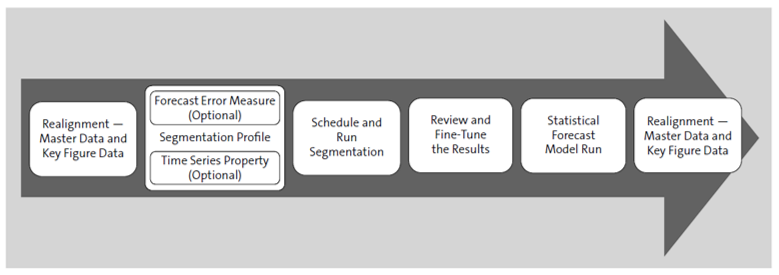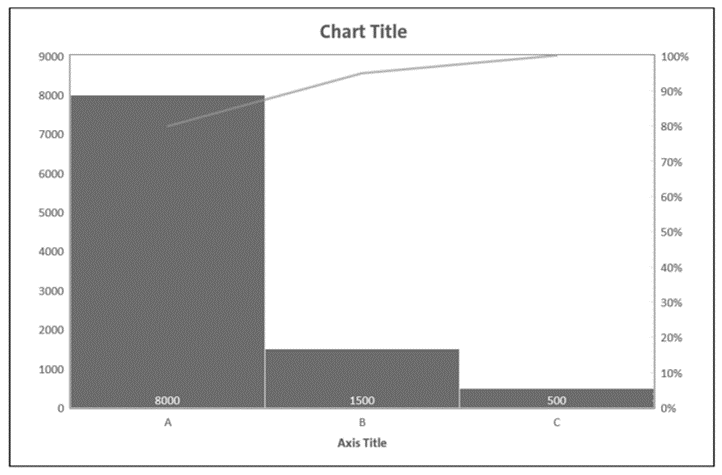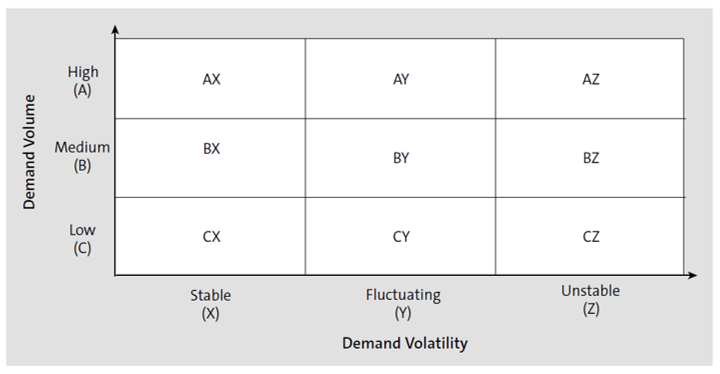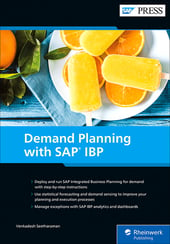One single plan for all products isn’t optimal due to different revenue amounts or volumes and forecast errors.
The demand planning process starts with data segmentation to get an accurate forecast and clear visibility into inventory. Data segmentation makes the day-to-day activities of planners much easier. You’ll see in detail different segmentations used in SAP Integrated Business Planning (SAP IBP) in this blog post.
The demand segmentation process is based on the process flow in SAP IBP for demand, as shown in the figure below. Data realignment can be before or after the ABC/XYZ segmentation.

The next process step is to create a segmentation profile in the Manage ABC/XYZ Segmentation Rules app. In this profile, the time series property results generated from the Manage Forecast Automation Profiles app and error measures generated from the Manage Forecast Error Calculations (Demand Planning) app can be used as input for the segmentation.
You can only schedule and run segmentation jobs in the Application Jobs app using SAP application template ABC/XYZ Segmentation. You can then review the results from the application logs in the web user interface (UI) and planning view in SAP IBP, add-in for Microsoft Excel, and fine-tune if required. Now you can run the statistical forecast models based on the segmentation filter for better planning results.
Planners are working large volumes of data without segmentation, which leads to a lack of prioritization and makes it difficult to focus and plan their product portfolio effectively. Data segmentation helps them define groups of entities with the same characteristics. ABC/XYZ segmentation is the method to group the planning based on the selected key figure and master data attributes.
ABC and XYZ segmentation work differently to group the planning objects.
ABC Segmentation
This segmentation prioritizes the planning objects based on their revenue or volume. For example, you can group the historical forecasts based on the material type of products.
XYZ Segmentation
This segmentation is used to classify the planning objects based on the demand variability. For example, you can measure different coefficients of variation for a product from growth to declining phase.
Segmentation is a key input for demand planning and inventory optimization to measure the accuracy of a forecast. There are many options to segment the planning objects using segmentation profiles. By default, ABC/XYZ segmentation is an attribute in the product master data of SAP IBP for demand. But you can extend the attribute to any master data type (e.g., customer source) based on the business requirement. In addition, the ABC/XYZ segmentation profile can be used with time series analysis input and forecast error measure as an optional input, as we discuss below.
Time Series Analysis (Optional)
SAP IBP analyzes the historical key figure data based on predefined parameters and identifies the data pattern. Time series analysis is based on the transaction data. These time series results are used in statistical forecast algorithms and XYZ segmentation to further refine the output. This functionality is used with the Manage Forecast Automation Profiles app.
Forecast Error Measure (Optional)
You can select forecast error measure as an input for XYZ segmentation based on the results generated by the Manage Forecast Error Calculations app with calculation strategy Aggregate over Periods with aggregation method Average.
ABC and XYZ segmentation are found together within a single profile—the ABC/XYZ segmentation profile. But you can use it together or separately based on the business requirement. In addition, you can use multiple ABC/XYZ segmentation profiles within a planning area. Let’s discuss the key fundamental concepts to ABC/XYZ segmentation.
ABC Segmentation
ABC segmentation prioritizes the products based on their group category. ABC segmentation is grouped based on the Pareto principle, also called the 80/20 rule, where 80% of the problem is due to 20% of causes. In SAP IBP for demand, this can be applied as 20% of products (A) are deriving 80% of the company’s revenue. The rest of the 80% of products (B and C) is generating the remaining revenues. Classifying A, B, and C will help planners focus on the A and B products over C. SAP standard segmentation is 70% for A, 20% for B, and 10% for C, but this can be adjusted based on your requirements. The figure below shows the ABC segmentation based on the Pareto principle with A, B, and C as 80%, 15%, and 5%, respectively.

SAP delivers ABC/XYZ segmentation attributes in product master data. But based on the project requirement, this can be enhancing location-product or customer-product master data with additional attributes. ABC segmentation can be used as the criteria for statistical forecast runs in demand planning.
XYZ Segmentation
XYZ segmentation prioritizes based on demand volatility segmentation, calculating the volatility of individual product volume, revenue, or location-product.
In the figure below, you can see an example of XYZ segmentation where products are varying from predictable to unpredictable in 12 months of demand with the following trends:
- X: Stable demand and predictable products in the measurement period
- Y: Fluctuating demand and predictable products in the measurement period
- Z: Highly unstable demand and unpredictable products in the measurement period

So far, you’ve seen that ABC segmentation is the prioritization of planning objects (product or location-product) based on their importance and that XYZ segmentation is a classification of planning objects (product or location-product) based on demand volatility. The final figure shows the nine combinations of ABC and XYZ segmentation. Planning objects will be segregated within these nine segments with two characteristics: demand volume and volatility. ABC/XYZ segmentation helps planners identify which combinations to focus their efforts on to reach their target.

Editor’s note: This post has been adapted from a section of the book Demand Planning with SAP IBP by Venkadesh Seetharaman.



Comments